I have used the Austin Powers movies to explain my point in a review before. It’s an unorthodox approach, but I guess when you have a tool that so succinctly parodies the silliest tropes of action stories, you have to use it.
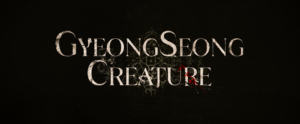
The movies came to mind twice as I watched part two of Netflix’s end-of-year blockbuster, Gyeongseong Creature, signalling the exact problems it ultimately faces. It isn’t flattering to compare a historical action-come-horror-come-romance to a spoof film. But when so many of its plot points end up feeling predictable, and so many moments throughout are peppered with major conveniences and coincidences, one’s mind wonders to the absurd end-point that this type of writing implies.
The first of these moments of comparison is minor but telling, and yet again demonstrates the costuming department’s fear to stray away from anything that makes its leads look less beautiful. Our two heroes, Jang Tae-sang (Park Seo-joon) and Yoon Chae-ok (Han So-hee), whilst variously infiltrating and escaping the military Onseong Hospital, attack two guards and steal their uniforms to disguise themselves as soldiers. The outfits that they wear (and in Jang’s case, it appears that he does this more than once) fit them perfectly, an idea lampooned in Austin Powers when he and his partner manage the same trick, stealing the clothes of one ridiculously tall and one ridiculously short person.
The second instance is straight from Doctor Evil, who, upon capturing his nemeses, deliberately points out that he is going to leave them unguarded and unmonitored while slowly lowering them into a surely fatal trap. Needless to say, the heroes escape. It’s a jab at just how flimsy the plot machinations often are that allow our favourite characters to escape seemingly obvious fates, and it came to mind a lot in the last three episodes of this action-driven horror piece.
This is the central problem of Gyeongseong Creature. Whilst the final three episodes certainly ramp up the tension and action, leaving any sense of whimsy from the show’s opening behind, there is nothing really bold in the storytelling. It ends as a show laiden with plot armour, where everyone ultimately does what we expect, and the true horror that is supposed to be explored through metaphor is side-lined for romantic melodrama and late additions to the storyline.
This review contains spoilers.
The horror and action elements of Gyeongseong Creature were at their apex at the close of episode seven, with the pregnant Myeong-ja (Ji Woo) free from the hospital, as well as the surviving independence prisoners and our main cast, minus Jang. After the climax of a breakout from an evil prison/laboratory, and revelations as to the nature of the monster at its heart, there are loose ends to be tied up, and decisions to be made as to where to move the narrative next.
Some of these decisions are intriguing, not least the idea of the monsters’ creation being the result of a parasitic serum that can turn its hosts into savage killers. This is the idea dropped into the final shots of episode seven, and in the last three episodes this is developed into a plotline where Myeong-ja (the Japanese police commissioner’s pregnant mistress) becomes monstrous herself. Ripping the brains out of unsuspecting victims through their eyes (nice), she gains superhuman strength and agility, while retaining flashes of her former innocent self. She cuts a frightening but pathetic figure as she tries—and fails—to escape arrest and recapture by the Japanese military while she runs through the forests in a bloodied hanbok, her mouth encrusted with blood.
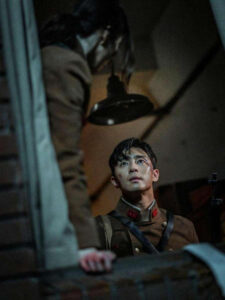
This particular storyline refreshes the horror elements that the audience was familiarised with in part one, and provides one of the most poignant allegories for the violence that was enacted against Korean women during this period. Ji Woo is movingly doe-eyed and bewildered by her violent fate, and the imagery of her violent acts, contrasted with the cage she is later forced into, is striking.
Unfortunately, the success of this storyline puts it in the minority in this show. Perhaps, given the star power of its leads, the writers were reluctant to step away from a romance subplot. And of course, in K-dramas, romance is notoriously thrown in with any and all other genres all the time: why not here?
The answer doesn’t lie in the performances, as solid as they are. Park shines as a charmer and top dog, while Han is strong in the emotional moments, of which there are many in the closing episodes. It’s just that their romance never feels like it makes any sense other than as some kind of fan-service. Aside from a few scenes scattered throughout of them spending quiet time together (the scene where they buy dumplings is a brief moment of lightness in the show’s final section), there is little here to explain why their love develops, let alone becomes undying. As these are the two central characters of the drama, this decision to include romance means that the audience sees rather a lot of dramatic promises of devotion and yearning looks. It is both a tonal mismatch, and a weakly written element of the narrative.
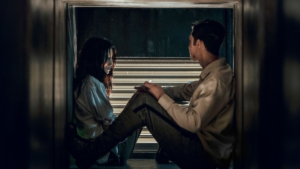
Maybe it is because of the show’s consistent unwillingness to drop one of its several genres—horror, romance, action, thriller, historical—that this weakness comes about. The emphasis on this central romance does have the unfortunate side effect of maligning the horror elements (more monster, less longing please), as well as making a lot of the action that much more predictable. In episodes eight and nine, we can be pretty certain that neither Jang nor Yoon will die in their many daring raids, because that won’t satisfy their romantic arc. It makes otherwise well-directed escape action sequences feel unnecessary: we know that, somehow, the villain will fail disastrously at their task and effectively hand them the keys to freedom. Or close enough.
We can also rest assured that they will remain beautiful, a frustrating hangover from the beginning of the series. Gyeongseong features some really impressive injury and gore makeup in its supporting characters. The deep gashes on Commissioner Ishikawa (Kim Do-hyun)’s face and neck ooze with claret-coloured blood, and both Mrs. Nawol (Kim Hae-sook) and Gu Gap-pyeong (Park Ji-hwan)’s faces are horrendously bruised and swollen after each undergoes torture.
However, the injuries that both of our leads receive, even up to the point of a tentacle through the stomach, never feel like more than conveniently placed grazes designed not to distort a single feature. It feels slightly lazy to not commit to every single character in the same way, and further undermines the potential in the relationship between the central couple.
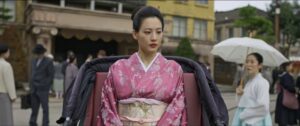
This lack of commitment in certain areas extends to plenty of overly opportune moments that spoil the story. There is so much to be said and explored around Japanese colonialism, their horrific experiments, and the machinations of the independence movement in Korea. But, in Gyeongseong, this complexity is ignored in favour of vaguely evil antagonists (centrally Claudia Kim as Lady Maeda: why is she doing what she’s doing so coldly?), soldiers who can never find a single hiding hostage, and fight scenes where everyone waits their turn to fight the leads. After the umpteenth gun battle in which plot armour saves all of our favourites, scenes that are supposed to have more emotional impact, such as the one where Maeda reveals the betrayal of Jang’s friends to him, fail, as we know that somehow everything will be OK again.
There are just so many of these machinations that it soon becomes clear that the story will go in a certain direction, with certain fates awaiting certain characters. This often ends up just raising more issues. For example, when we learn that the central monster is in fact Yoon’s mother, horribly mutated, and that she can still recognise her child, this just begs more questions. Can she recognise other people? If so, why did she so willingly kill and consume so many Korean prisoners, at least some of whom she would have seen whilst a human herself? There are a lot of holes revealed across the storylines in this way.
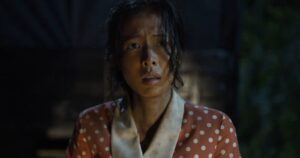
In the end, it feels like Gyeongseong Creature both tries to be too many things at once, and also doesn’t have the bravery to commit to every genre it attempts. There are arresting ideas and sequences; aside from Myeong-ja’s storyline, there is the opening of episode nine, showing a grainy black and white TV screen montage of colonial Korea and the suffering of the victims of Japanese experimentation. It’s a quiet and considered moment that shows respect to the reality of these concepts, but unfortunately the drama does not maintain the creativity of these moments throughout.
Whilst the performances are pretty universally engaging, and the cinematography has the now-expected Netflix sheen (they can make things go boom, and they do), it’s the execution of the narrative itself that lets the show down. Hopefully some of the many questions raised in season one will find a satisfactory answer in the already-in-the-works season 2.
This is teased at the end of season one, and has the intriguing premise of bringing the story into the modern day (the final shot sees Park Seo-joon opening his apartment window onto contemporary Seoul), which may clarify rather than confound the issues that came before. It is exciting to see Netflix jump this enthusiastically into big-budget, A-list starred, multi-genre colonial period fare in the K-drama world. Now they just need to make a stronger story for it.
(YouTube. Images via Netflix.)
0 Comments